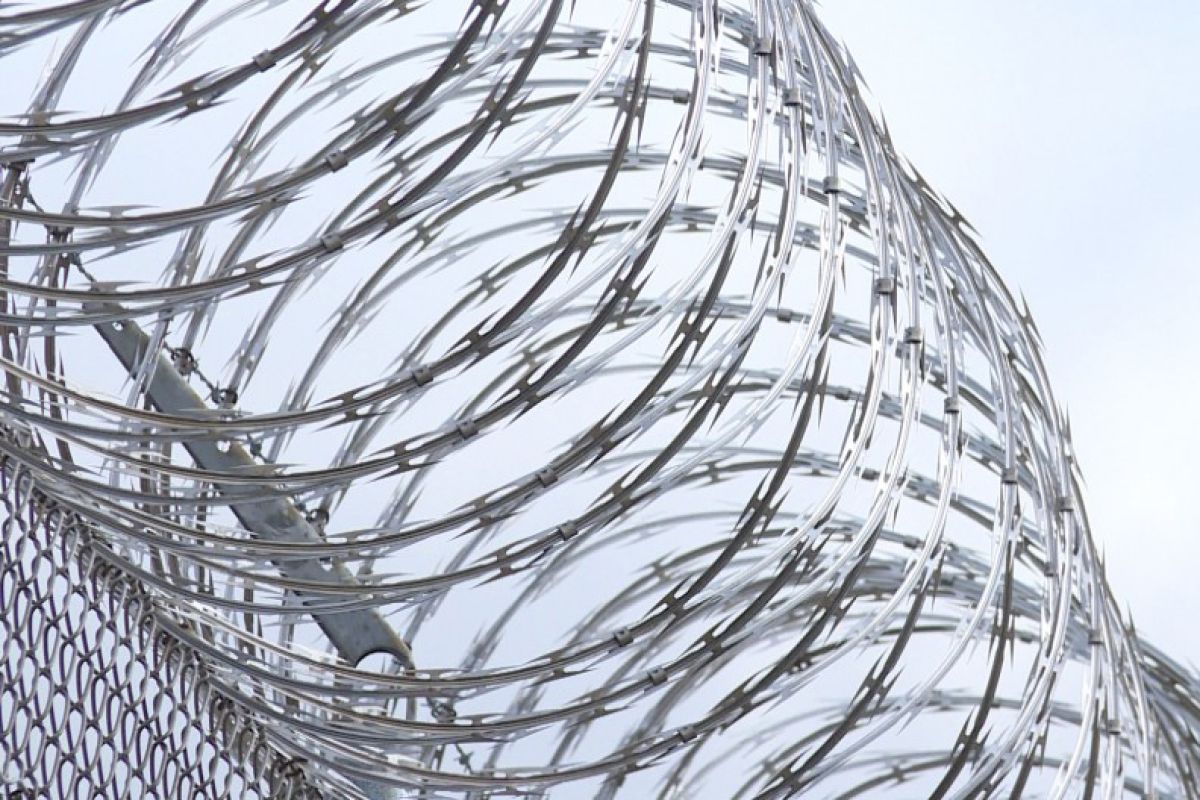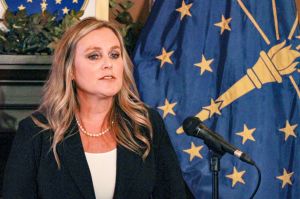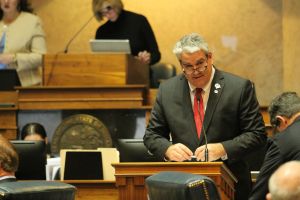
The U.S. prison bureau transferred Nasih Ra'id to Terre Haute in 2005.
A man who died on federal death row last month told loved ones he planned to kill himself in the weeks before U.S. prison staff reported finding his body.
Friends of Nasih Khalil Ra’id said he had been struggling to cope with conditions at the Federal Correctional Complex in Terre Haute, Indiana. The facility houses the U.S. prison bureau’s “Special Confinement Unit,” or federal death row.
They said Ra’id had been becoming increasingly hopeless since last fall, when the U.S. prison bureau moved every person on death row to a different part of the prison.
“I saw my friend deteriorating,” Rejon Taylor, a friend and fellow death row prisoner, wrote in a message. “The signs were apparent for anyone who cared to see.”
Read more: Man on federal death row found unresponsive, pronounced dead
Ra’id was passionate about physical fitness and strength training. But after relocating death row prisoners to the temporary unit, Taylor wrote, the prison also shut down opportunities to exercise — Ra’id’s primary coping mechanism.
“His weight-loss was noticeable. His once bulging biceps had atrophied. He had been most consistent with his exercise routine, no matter how he felt. It had kept depression at bay,” Taylor explained. “When rec was eventually made available to us, Nasih struggled to get back in rhythm … He’d fallen prey to the adverse conditions of our solitary confinement — a mental force stronger than any the body could withstand.”
Taylor’s description of Ra’id’s final days is the most detailed of three accounts reviewed by WFIU in the weeks since his unexplained death in federal custody, on Dec. 1, 2023.
A month later, the U.S. prison bureau still won’t say what happened to him.
“Beyond what was provided in the press release, we have no further information,” an unidentified official responded multiple times to emailed questions in December. The Dec. 1 press release offered few details and no answers.
The bureau also declined to discuss the temporary housing arrangement.
But prison staff told defense attorneys visiting the prison that the arrangement is to make way for repairs on federal death row, which they call “the SCU.”
Read more: Introducing: Rush to Kill, a new podcast from WFIU
“The whole SCU population was moved in October to deal with an electrical problem that surfaced when they were testing backup generator power and there is no real sense about when they will be returned to the SCU, although we have heard February,” death penalty attorney Margaret O’Donnell said.
O’Donnell, who represents several people on federal death row, also said the work sometimes disrupts scheduled legal calls and visits.
“While they are waiting on parts to fix the electrical problems, they are taking the opportunity to do some changing of things,” federal defender Monica Foster said. “Before they moved, they could not get the doors to open. That is obviously a problem.”
As the construction continues, prison staff are simultaneously attempting to outfit the new housing area to function as a temporary death row.
But that section is not equipped for solitary confinement. Basic services for these prisoners aren’t operating as they did in the permanent location. Recreation time remains reduced, and phones and email access are limited. Both malfunction more often than before.
Prisoners say the increased isolation is taking a toll on everyone’s mental health.
They say at least one other person has attempted to kill himself since the move.
Read more: Democrats reintroduce bill to abolish federal death penalty
Ra’id, whose legal name was Odell Corley, was sentenced to death in 2004.
A federal jury convicted him of multiple felonies including the murders of two people during a bank robbery in northern Indiana.
The prison bureau transferred Ra'id to Terre Haute in 2005.
“Corley asked me a few days before his death to help him file a motion to be executed because he knew I do legal work. But I didn’t help him,” Billie Allen, another prisoner on federal death row, wrote in a message.
“I think everyone knew he was ready to die, because he said so on many occasions,” Allen added. “He said that ‘this isn’t living,’ and I agree.”
Allen said Ra’id made his intentions known to multiple people before his death.
It’s not clear if any of them tried to warn prison staff.
The U.S. justice department stopped setting execution dates after President Joe Biden’s inauguration, in January 2021.
In summer 2021, Biden’s attorney general, Merrick Garland, announced a moratorium on carrying out federal death sentences. Garland said the justice department was studying changes made to execution procedures at the direction of his predecessor, Bill Barr.
In its final six months, the administration of President Donald Trump carried out 13 federal executions in quick succession.
Legislation to repeal the Federal Death Penalty Act is stalled in the U.S. Congress despite Biden’s campaign pledge to seek to end capital punishment at the federal level and encourage American states to follow suit.
While Biden hasn’t scheduled new executions, his justice department is seeking or defending death sentences in certain cases.
And even though they aren't facing imminent execution, death row prisoners are held in solitary confinement and spend most of their time alone in single-person cells.
Ra’id, in particular, complained about the isolation, friends said.
“Odell was frustrated because the visiting regulations here are very complicated for us,” a third prisoner, Edgar Garcia, wrote in a message, using Ra'id's legal name.
With exceptions for clergy and defense attorneys, U.S. authorities generally allow visits only from people the prisoners knew before arriving.
Read more: Lawsuit challenges isolation conditions on federal death row
“He and many of us have dealt with that struggle,” Garcia wrote. “I know how it affects us and it is like stripping us of hope, purpose ... We all deal with it in our own way, but Odell decided he had enough of this.”
According to prisoners, Ra’id died sometime after federal agents picked him up at the temporary housing area early on Dec. 1. They say he never returned.
The prisoners said the guards were taking Ra’id to a place recently designated for death row residents to exercise. Labeled “outdoor recreation,” the area is mostly covered. One day each week, prisoners say, people on death row can exercise inside individual cages.
“Nasih was escorted from his cell with his hands cuffed behind his back. He wore a grey sweatsuit, black Nike shoes, and a bluish-green face mask,” according to Taylor, the prisoner who was close friends with Ra’id. “Attached to him by a black shoulder strap was his mesh bag, which he often carried to rec,” he wrote.
The prisoners said another man on federal death row was with Ra'id during the same recreation period, although they were locked in separate cages. That man returned to the housing area and, according to the prisoners, described seeing Ra’id hang himself inside his cage. He told them Ra’id succeeded on the second attempt, using a strap from his bag.
It wasn't possible to independently verify details about Ra’id’s death. None of the prisoners who shared information with WFIU witnessed Ra’id die.
U.S. officials declined to provide basic facts such as a suspected cause of death, or the location inside the facility where staff found Ra’id “unresponsive” on Dec. 1.
It would be the first death by suicide since the unit opened in 1999, experts said.
Prison officials would not say if the death was under investigation.
The bureau also rejected requests to interview multiple prisoners, including Taylor, each time citing unspecified "safety and security concerns."
A bureau spokesperson declined to say if authorities released Ra’id’s body.
In late December, an employee at the Coleman & Hicks Chapel in Michigan City, Indiana, said the "final deposition” of Ra'id's remains was complete.
The chapel hosted a celebration of life followed by a private burial, the employee said.
Deborah Aldridge, one of Ra’id’s cousins, said the family was waiting for the prison bureau to share the results of its investigation.
Aldridge said authorities conducted an autopsy but didn’t share the findings.
In Terre Haute, Donna Weger, office manager for the Vigo County coroner, confirmed that an autopsy was conducted on Ra’id’s body.
Weger said the report on the autopsy wasn’t available.
Read more: Pence wants to expedite federal death penalty for mass shootings
Ra’id’s legal team declined to comment.
“We did represent Mr. Corley. For now we are not commenting but that could change,” attorney Shawn Nolan, chief of the Capital Habeas Unit at the Community Federal Defender Office for the Eastern District of Pennsylvania, wrote in an email.
In November, as word of Ra’id’s plans spread, friends said they tried to intervene.
“I would see Nasih sitting in his cell in the dark, his posture collapsed, his head hung low in defeat. Sometimes he would be lying on his thin mattress, listless, staring at the ceiling. I had never seen him in such a state before,” Taylor wrote.
“'Dude, what's up with you?’ I would ask him,” Taylor said. “He confessed that he was weighed down with depression, his thoughts orbiting around his suicide.”
Taylor said Ra’id made up his mind to kill himself by his 59th birthday, Nov. 27.
Read more: Federal death row ministers sue for contact during prayer, executions
“I tried reasoning with him, to talk him down, but nothing I said convinced him to change his mind,” Taylor wrote. “Don't try to stop me. Just let me go.”
Taylor said he still raised the alarm, telling others on death row “to cut him off from getting what he needed” to carry out a suicide attempt.
After Nov. 27 came and went, “I thought we were out of the woods,” Taylor explained. “I checked on him less. I let my guard down.”
Until the morning of Dec. 1, he said, “and the illusion shattered.”
Cathy Knapp contributed to this report.











